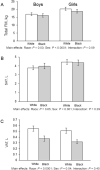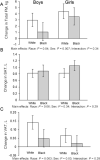Visceral, subcutaneous, and total fat mass accumulation in a prospective cohort of adolescents
- PMID: 35544287
- PMCID: PMC9437989
- DOI: 10.1093/ajcn/nqac129
Visceral, subcutaneous, and total fat mass accumulation in a prospective cohort of adolescents
Abstract
Background: Race and sex differences in adolescents' body fat are demonstrated in cross-sectional cohorts, yet a longitudinal design would better identify patterns of fat distribution over time.
Objectives: The aim was to examine race and sex differences in adiposity between black and white adolescents over 2 y.
Methods: A cohort of adolescents aged 10-16 y (38% black; 52% girls; 15% overweight, 34% with obesity) underwent body composition measurements at baseline (n = 309) and 2 y later (n = 236), using DXA to quantify whole-body fat mass (FM) and MRI for abdominal subcutaneous (SAT) and visceral adipose tissue (VAT) volumes. General linear models were used to examine race and sex differences in log-transformed FM, SAT, and VAT, adjusting for age, sexual maturation, extended BMI percentile, and race-by-sex interaction. SAT and VAT models in addition controlled for baseline FM and change in FM (for change models).
Results: Mean (95% CI) baseline FM (kg) was higher among white [18.5 (17.9, 19.2) than among black adolescents [17.4 (16.6, 18.2), P = 0.03] and girls [19.5 (18.8, 20.3) than boys [16.5 (15.8, 17.2), P < 0.0001]. Mean (95% CI) baseline SAT (L) was higher among girls [4.4 (4.2, 4.6)] than among boys [3.9 (3.7, 4.1), P < 0.0001]. Mean (95% CI) baseline VAT (L) was higher among white [0.5 (0.5, 0.6)] than among black [0.3 (0.3, 0.4)] adolescents (P < 0.0001) and boys [0.5 (0.4, 0.5)] than girls [0.4 (0.4, 0.4), P = 0.04]. Over 2 y mean (95% CI) FM change (kg) was higher among white [3.7 (2.9, 4.5)] than among black adolescents [2.3 (1.3, 3.3), P = 0.04] and girls [4.0 (3.0, 4.9)] than boys [2.0 (1.1, 3.0), P = 0.007], but SAT change (L) did not differ by race or sex. VAT change (L) was higher among white [0.1 (0.1, 0.1)] than among black adolescents [0.0 (0.0, 0.1), P = 0.003] and boys [0.1 (0.1, 0.1)] than girls [0.0 (0.0, 0.1), P = 0.034].
Conclusions: Sex and race differences in the deposition and accumulation of excess fat are important considerations for understanding obesity prevalence and obesity-related disease risk among adolescents.This trial was registered at clinicaltrials.gov as NCT02784509.
Keywords: African Americans; abdominal fat/diagnostic imaging; adipose tissue/anatomy and histology; ectopic fat; intra-abdominal fat/diagnostic imaging; longitudinal studies; obesity/ethnology; racial groups/genetics; sex characteristics.
© The Author(s) 2022. Published by Oxford University Press on behalf of the American Society for Nutrition.
Figures


Similar articles
-
Visceral adiposity and inflammatory bowel disease.Int J Colorectal Dis. 2021 Nov;36(11):2305-2319. doi: 10.1007/s00384-021-03968-w. Epub 2021 Jun 9. Int J Colorectal Dis. 2021. PMID: 34104989 Review.
-
The relationship of waist circumference and BMI to visceral, subcutaneous, and total body fat: sex and race differences.Obesity (Silver Spring). 2011 Feb;19(2):402-8. doi: 10.1038/oby.2010.248. Epub 2010 Oct 14. Obesity (Silver Spring). 2011. PMID: 20948514 Free PMC article.
-
Gender differences in the association of visceral and subcutaneous adiposity with adiponectin in African Americans: the Jackson Heart Study.BMC Cardiovasc Disord. 2013 Feb 22;13:9. doi: 10.1186/1471-2261-13-9. BMC Cardiovasc Disord. 2013. PMID: 23433085 Free PMC article.
-
Ethnic and sex differences in body fat and visceral and subcutaneous adiposity in children and adolescents.Int J Obes (Lond). 2012 Oct;36(10):1261-9. doi: 10.1038/ijo.2012.95. Epub 2012 Jun 19. Int J Obes (Lond). 2012. PMID: 22710928 Free PMC article. Review.
-
Does Visceral or Subcutaneous Fat Influence Peripheral Cortical Bone Strength During Adolescence? A Longitudinal Study.J Bone Miner Res. 2018 Apr;33(4):580-588. doi: 10.1002/jbmr.3325. Epub 2017 Nov 27. J Bone Miner Res. 2018. PMID: 29083059 Free PMC article. Clinical Trial.
Cited by
-
Association of weight-adjusted-waist index with non-alcoholic fatty liver disease and liver fibrosis: a cross-sectional study based on NHANES.Eur J Med Res. 2023 Aug 3;28(1):263. doi: 10.1186/s40001-023-01205-4. Eur J Med Res. 2023. PMID: 37537679 Free PMC article.
-
Predictors of visceral and subcutaneous adipose tissue and muscle density: The ShapeUp! Kids study.Nutr Metab Cardiovasc Dis. 2024 Mar;34(3):799-806. doi: 10.1016/j.numecd.2023.12.014. Epub 2023 Dec 19. Nutr Metab Cardiovasc Dis. 2024. PMID: 38218711 Free PMC article.
-
The Critical Role of Body Composition Assessment in Advancing Research and Clinical Health Risk Assessment across the Lifespan.J Obes Metab Syndr. 2025 Apr 30;34(2):120-137. doi: 10.7570/jomes25010. Epub 2025 Apr 8. J Obes Metab Syndr. 2025. PMID: 40194886 Free PMC article. Review.
References
-
- Fryar CD, Carroll MD, Ogden CL. Prevalence of overweight, obesity, and severe obesity among children and adolescents aged 2–19 years: United States, 1963–1965 through 2015–2016 [Internet]. Hyattsville, MD: National Center for Health Statistics; 2018. [Accessed 2022 May 20]. Available from: https://www.cdc.gov/nchs/data/hestat/obesity_child_15_16/obesity_child_1....
-
- Daniels SR, Khoury PR, Morrison JA. The utility of body mass index as a measure of body fatness in children and adolescents: differences by race and gender. Pediatrics. 1997;99(6):804–7. - PubMed
-
- Daniels SR, Morrison JA, Sprecher DL, Khoury P, Kimball TR. Association of body fat distribution and cardiovascular risk factors in children and adolescents. Circulation. 1999;99(4):541–5. - PubMed
Publication types
MeSH terms
Associated data
Grants and funding
LinkOut - more resources
Full Text Sources
Medical
Research Materials

